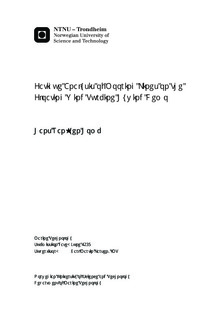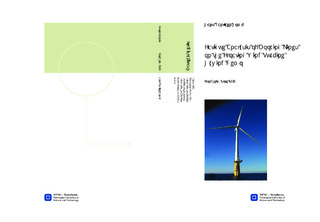| dc.description.abstract | In the last decades the focus on developing renewable energy has increased tremendously. The main reason for this is the rapid increase of population, which requires enormous amounts of energy. Eventually we will run out of non-renewable energy which makes us reliable of the renewable energy, for example wind energy.
Statoil?s response to this has been to design and create the Hywind Demo concept. An almost conventional wind turbine placed on top of a SPAR-buoy creates the basic idea.
The Hywind Demo presents many interesting and challenging problems, where fatigue is one of them. It shall withstand harsh and rough weather over a long period of time. It is self-explanatory that this challenge not can be solved too quickly, but solved with focus on the correct results. The mooring lines on the Hywind Demo introduce big issues, both regarding design and cost. As the depth increases, the required length of the mooring lines increases more, and this may cause problems. Also the footprint represents a huge factor, as-well as the detailed design of the long mooring lines. I have focused on the fatigue damage on the mooring lines.
This report investigates three main methods of approaching fatigue damage: Linear Time Domain, Non-linear Time Domain and Frequency Domain. The Linear Time Domain analyses were discarded due to the fact that the turbine rotor cannot rotate in a linear time domain analysis (the stiffness matrix for the rotor needs to be updated, which it can?t in a linear time domain analysis). A way of solving this problem would require a lot of work on the model, and linear analyses were hence not carried out.
After the non-linear time domain simulation of the Hywind Demo, a fatigue calculation was done. The Rainflow counting method was used in order to calculate the fatigue damage. The results from this fatigue calculation showed similar results as Statoil?s own results (compared with a fatigue evaluation based on the Rainflow technique). The expected life time for the ?As-Built?-model (15 degree offset) was calculated to be 93.7 [years].
The worst sea state was done by first simulating 13 different sea states and then doing a peak parameter study. From the first study I found the significant wave height that produced most fatigue, while the second study consisted of a sensitivity study on the peak periods. The final result was that the most yearly damage occurs when HS = 3.0 [m] and TP = 8.0 [s].
The next topic discussed in my report was a ?rotation matrix method?. In the Metocean specification for the Hywind Demo location, the probability and angles for the waves are presented. The basic idea is to calculate total fatigue damage from the Metocean specification with only doing analyses on a few directions. The only requirement for doing this method is that the system must have at least one symmetry place. This method was demonstrated as a possible way of reducing number of calculations needed. The expected life time based on the wave directions and probability was 92.7 [years].
A parameter study of the clump weights revealed that it is not optimized in terms of fatigue. The existing weight of a single clump weight is 66645 [kg in air]. The highest fatigue was found with only 2 [tons] lighter clump weight (64645 kg in air). Therefore, introducing a clump weight weighing less than 63645 [kg in air] or more than 66645 [kg in air] will reduce the fatigue damage. A requirement of enough yaw-stiffness for the Hywind Demo will favor an increase of the clump weights.
Calculating the fatigue damage in the frequency domain was based on a closed form solution. This requires that the S-N curve is linear and that the time series is narrow banded. In this case the time series from the stresses were not narrow banded, it was assembled by the ?slow-motion? and the ?wave-motion?. The solution was to filter these two processes apart, then calculating the contributions from the two processes individually. It is important to emphasize that this is a very simplified weight of solving the problem, normally weight functions are applied when calculating like this. The results from this method gave only slightly lower results (4.6%) than the results from the rainflow-technique on the non-linear time domain analyses. This means that both of the methods works for the mooring line system on the Hywind Demo and that the solution from the Rainflow-technique is slightly more conservative. Both methods are very computational efficient. | |

